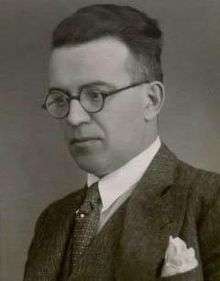Vladimir Šubic
Vladimir Šubic (23 May 1894 – 16 November 1946)[1] was a Slovene architect. He designed many buildings, most notably Nebotičnik in Ljubljana, which was the tallest building in Yugoslavia upon its completion.[2]
Vladimir Šubic | |
|---|---|
 | |
| Born | May 23, 1894 |
| Died | November 16, 1946 (aged 52) |
| Occupation | Architect |
Life
Šubic was born in Ljubljana, then the capital of the Duchy of Carniola, part of Austria-Hungary.[3] He began his studies at the Technical University of Vienna in 1912, studying mechanical engineering.[1] He studied shipbuilding at the University of Graz a year later, and in 1919 enrolled in the department of architecture at VTŠ in Prague.[1] He passed his final examinations in 1922 and began his career as an architect and engineer.[1][4]
He returned to Ljubljana, then part of the Kingdom of Serbs, Croats and Slovenes and soon became a successful architect. His interest in contemporary architectural developments led him to design the first Slovene skyscraper, based on the most recent architectural developments.[2]
After World War II his career became endangered because of his liberal worldview, regarded as hostile by the new Communist authorities. He was first imprisoned on secret charges and sentenced to forced labor,[1] and then released and denied work.[5] In 1946, he was sent by the Titoist regime of the Federal People's Republic of Yugoslavia to the work brigade in Bosnia, to work as an engineer on the construction of the Brčko-Banovići railway line. He died in Lukavac building the line the same year under unknown circumstances, although the cause of death was officially reported as a heart attack.[5] He is buried in the Škofja Loka cemetery.[6]
Buildings
Vladimir Šubic was the architect of many buildings. Below is a list of his more notable accomplishments:
- The Nebotičnik high-rise
- The Koehler Mansion
- The Meksika apartment house
- The Chamber of Labour (Delavska zbornica), now the seat of the Slovenian Cinematheque
- Several apartment blocks for the Pension Fund Institution (Pokojninski zavod)
- The tomb for the Jelačin family
- The Šubic Mansion
- The Palace of Trade
- The Grafika Palace
- The Palace of Trade Academy
- The Udarnik Cinema in Maribor
- The Putnik Pavilion in Belgrade
See also
- Mirko Šubic
- Ivan Vurnik
References
- Bernik, Stane. 1999. "Vladimir Šubic." Enciklopedija Slovenije, vol. 13. Ljubljana: Mladinska knjiga, p. 163.
- Ifko, Sonja (1995), Recent Slovenian Architecture Archived 2007-12-30 at the Wayback Machine, University of Ljubljana, pp. 13. Retrieved 3 December 2007.
- Akademska in raziskolvalna mreža Slovenije. Date and place of birth and death for Vladimir Šubic. Retrieved 6 January 2007.
- (in Slovene) dogaja.se - Vladimir Šubic, Arhitekt. Outlines education history. Retrieved 6 January 2008.
- Balantič, Polona. 2010. "Vladimir Šubic: Od triumfa z Nebotičnikom do smrti med mladinskimi brigadami." MMC RTV SLO (30 April). (in Slovene)
- Mušič, Marjan. "Šubic, Vladimir (1894–1946)". Slovenska biografija (in Slovenian). Slovenian Academy of Sciences and Arts. Retrieved 13 June 2015.
External links
| Wikimedia Commons has media related to Vladimir Šubic. |
- Vladimir Šubic, Arhitekturni vodnik